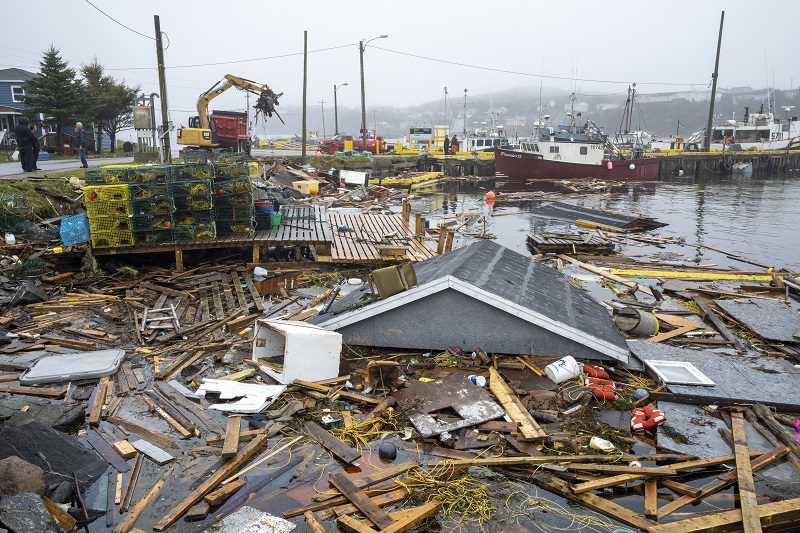What happened to the ‘quiet’ hurricane season?

Not long ago, hurricane season began very quietly with no North Atlantic hurricanes in all of August. But now it appears 2022 could produce a record-breaking hurricane season.
Property data provider CoreLogic is predicting Hurricane Ian could be the costliest Florida storm since Hurricane Andrew in 1992. Ian will have an industry-changing impact on the future of the real estate industry and infrastructure, CoreLogic said in a press release Friday.
According to its data analysis, wind losses for residential and commercial properties in Florida are expected to be between US$22 billion and US$32 billion. Insured storm surge losses in the state are expected to add an additional US$6 billion to US$15 billion to that tally.
“A record number of homes and properties were lost due to Hurricane Ian’s intense and destructive characteristics,” said Tom Larsen, CoreLogic’s associate vice president of hazard & risk management. “Hurricane Ian will forever change the real estate industry and city infrastructure. Insurers will go into bankruptcy, homeowners will be forced into delinquency and insurance will become less accessible in regions like Florida.”
Here at home, claims are coming in across a variety of personal and commercial lines in the wake of post-tropical storm Fiona, which struck eastern Quebec and Atlantic Canada beginning on Sept. 24. More than half a million people lost power, with the storm washing away homes and cottages, and causing widespread flooding and infrastructure damage.
Adjusters told Canadian Underwriter they’re using a mix of desk deployment for smaller claims and field deployment for larger ones.
A worker begins the process of cleaning up after post-tropical storm Fiona, in Charlottetown, Monday, Sept. 26, 2022. Across the Maritimes, eastern Quebec and in southwestern Newfoundland, the economic impact of the storm’s wrath is still being tallied. THE CANADIAN PRESS/Brian McInnis
“We’ve got adjusters being deployed to sit behind a desk to work with people on those smaller claims – the food spoilage claims, things like that…,” said CRU Group CEO David Repinski. “We’ve also deployed a fair number of field adjusters to do the actual physical inspections on the more significant losses.”
CRU is currently seeing property claims, but expects more auto claims in future.
“Depending on where they are and the significance of the storm surge, you’re going to have some cars that were flooded out,” Repinski said. “There’ll be a bit of a lagging indicator, but we’ll see those arise as well.”
For ClaimsPro, it can be challenging to get onsite in some of the more remote areas impacted by the storm.
“Many of the smaller regions still do not have power so we have centralized our adjusters in the larger centres and we are mobilizing them to travel in and out of the more remote locations, ideally in clusters for efficiency,” Anita Paulic, ClaimsPro’s director of operations & catastrophe response, told CU on Sept. 28. “Logistics are a challenge, but we expect things to be mitigated as power is restored and we can move out more broadly for longer durations.”
Sedgwick in Canada expects the storm to be a “significant claims event.” Similar to what CRU reported, Sedgwick said its current case load is mostly personal lines, but Michael Galea, senior vice president of operations with Sedgwick in Canada, added “we anticipate an increased amount of auto, commercial/industrial, municipal, and specialty losses due to wind and water.”
ClaimsPro is seeing everything from total losses, such as houses being washed away to rooftops being peeled off commercial buildings, to downed trees and losses caused by power outages, Paulic said. She also expects more business interruption losses.
Crawford & Company (Canada) is seeing auto, personal and commercial lines claims. “There are a lot of downed trees that have made impact with cars, homes and businesses,” said Crawford Canada’s chief client officer, Heather Matthews. “We are also seeing infrastructure claims and claims for government buildings.”
Aon’s weekly Cat report said “losses are anticipated to be in hundreds of millions (USD), even higher.” DBRS Morningstar estimated Fiona could cost the Canadian P&C industry between $300 million and $700 million, making it one of the largest Cat events for Atlantic Canada.
Aon’s report said the storm produced maximum gusts of 177 km/h in the Wreckhouse area of Newfoundland and Labrador, and destroyed or washed at least 76 homes into the sea. Osborne Head, N.S. received 192 mm of rain, while a tidal gauge at Port aux Basques, Nfld. set a record peak of 2.75 metres, the highest for the station extending back to 1935.
Feature image: Heavy machinery clears up washed up buildings and rubble in the harbour in Burnt Island, Newfoundland and Labrador on Tuesday September 27, 2022. Fiona left a trail of destruction across much of Atlantic Canada, stretching from Nova Scotia’s eastern mainland to Cape Breton, Prince Edward Island and southwestern Newfoundland. THE CANADIAN PRESS/Frank Gunn



